November 22, 2008
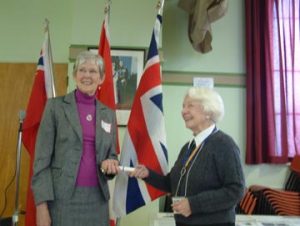 A good turnout came for our AGM and election of the new slate of officers for 2009. Member Elizabeth Elston came from Peterborough to be presented with a 20-year certificate.
A good turnout came for our AGM and election of the new slate of officers for 2009. Member Elizabeth Elston came from Peterborough to be presented with a 20-year certificate.
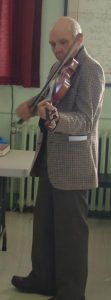
Five members then brought “Show and Tell”. First, John Buck entertained us with an old fiddle tune, “Buckwheat Batter”, that our Loyalist ancestors might also have heard.
Lorraine Abel told a very interesting story, that connected back to a meeting several years ago, when Sue Bazely of the Cataraqui Archaeological Research Foundation spoke to us about “Lost Cemeteries of Kingston”. Sue mentioned that recent excavations under the parking lot of Bethel Church had disturbed bones from several burials, including one intact coffin with a plaque on it identifying the person inside — none other than Jacob Vosburgh, Lorraine’s ancestor. Jacob and the unknown bodies have all been re-interred at Cataraqui Cemetery, Section K. Lorraine displayed a photo of the very nice stone that family members have erected, now that they know where he is buried. His wife was buried in Rochester, New York (where she apparently went for treatment of tuberculosis), and they had wondered where Jacob ended up. Now they know! What a happy ending. As a footnote, Lorraine mentioned that Jacob’s father John C. Vosburgh fought on the U.S. side, and that the late Kate Smith, singer of “God Bless America”, was also descended from John C.
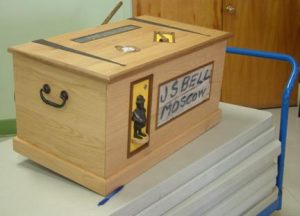
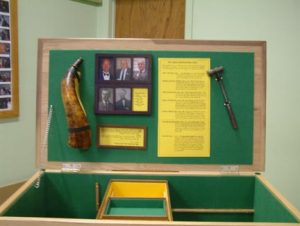 Lynn Bell displayed the “Grandfathers Chest” he’s made for his grandson. Embedded in it are such artifacts as a hammer Lynn got as a child; his father’s Kiwanis pin and toy bank; plus pocket watch, pipe and powder horn belonging to Lynn’s grandfather, great-, and 2-great- grandfathers. The panel addressed to J.S. Bell, Moscow came from an old shipping crate, and the hinges are equally old. The eldest Bell is commemorated by a reproduction of his Loyalist land claim. Lynn has included photos where available, and a pedigree of all the Bell ancestors involved in this chest. Lynn said he hopes to make similar chests for his four granddaughters. What a wonderful way to convey the past to the future generations!
Lynn Bell displayed the “Grandfathers Chest” he’s made for his grandson. Embedded in it are such artifacts as a hammer Lynn got as a child; his father’s Kiwanis pin and toy bank; plus pocket watch, pipe and powder horn belonging to Lynn’s grandfather, great-, and 2-great- grandfathers. The panel addressed to J.S. Bell, Moscow came from an old shipping crate, and the hinges are equally old. The eldest Bell is commemorated by a reproduction of his Loyalist land claim. Lynn has included photos where available, and a pedigree of all the Bell ancestors involved in this chest. Lynn said he hopes to make similar chests for his four granddaughters. What a wonderful way to convey the past to the future generations!
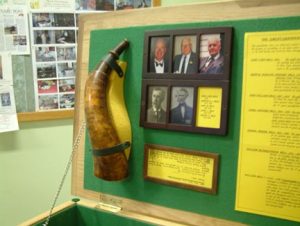
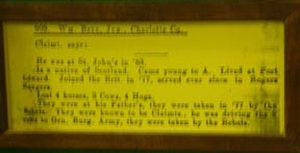 Lynn also showed an enlarged sample of binder pages he’s creating for his grand-children. Each has a copy of an original document such as a will or land grant, then a typed transcription of the document, and finally a paragraph or two outlining the relationship between his grandchildren and the author of the document. Another great way to make family history more interesting for young people!!
Lynn also showed an enlarged sample of binder pages he’s creating for his grand-children. Each has a copy of an original document such as a will or land grant, then a typed transcription of the document, and finally a paragraph or two outlining the relationship between his grandchildren and the author of the document. Another great way to make family history more interesting for young people!!
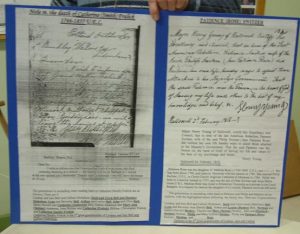
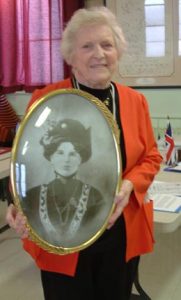 Marguerite Colpitts proudly displayed a beautiful photo of her mother, Sarah Jane Babcock, 1895-1997. Sarah descended from Benjamin Babcock, UE, of Adolphustown. Sarah was married at age 18 to William Franklin Good, and moved to Temiskaming in northern Ontario. While he worked in lumbering, Sarah shot rabbits and partridge, and cooked them for the crew of workers. They returned to Parham and a farm off the Long Lake Road. Sarah’s early life may have been almost as hard as that of her Loyalist ancestors, but she encouraged all her children to get as much education as possible, including her daughters. Marguerite said that Sarah would have been very proud of two great-granddaughters who are currently studying medicine at the University of Ottawa.
Marguerite Colpitts proudly displayed a beautiful photo of her mother, Sarah Jane Babcock, 1895-1997. Sarah descended from Benjamin Babcock, UE, of Adolphustown. Sarah was married at age 18 to William Franklin Good, and moved to Temiskaming in northern Ontario. While he worked in lumbering, Sarah shot rabbits and partridge, and cooked them for the crew of workers. They returned to Parham and a farm off the Long Lake Road. Sarah’s early life may have been almost as hard as that of her Loyalist ancestors, but she encouraged all her children to get as much education as possible, including her daughters. Marguerite said that Sarah would have been very proud of two great-granddaughters who are currently studying medicine at the University of Ottawa.
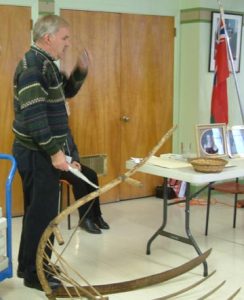 Jim Long brought a grain cradle to show us. It was, in its time, a great improvement over a simple scythe, since it combined the cutting edge of the scythe with a cradle that could collect the cut grain. Three swings of the cradle would cut enough to fill it, for tying a sheaf of wheat. This cradle comes from the Tamworth area, on the Arden road. One or two swings of the cradle are enough to remind anyone how hard our Loyalist ancestors had to work on their farms!
Jim Long brought a grain cradle to show us. It was, in its time, a great improvement over a simple scythe, since it combined the cutting edge of the scythe with a cradle that could collect the cut grain. Three swings of the cradle would cut enough to fill it, for tying a sheaf of wheat. This cradle comes from the Tamworth area, on the Arden road. One or two swings of the cradle are enough to remind anyone how hard our Loyalist ancestors had to work on their farms!
The meeting ended with a pre-Christmas tea, and a surprise for John Matheson. Our long-time member recently turned 91, and members enthusiastically sang “Happy Birthday” and presented a cake to our own “Father of the Canadian Flag”.
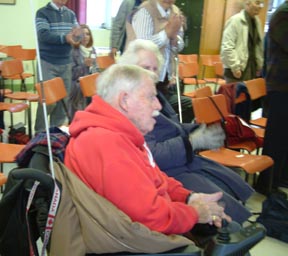
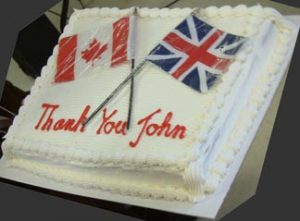
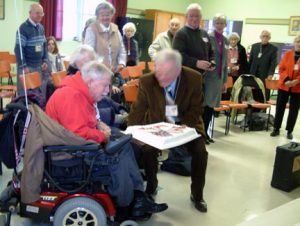
June 11, 2008
 Members and guests filled the room at the Donald Gordon Centre, Queen’s University on Wednesday, June 11th. We enjoyed an excellent dinner and good conversation, then a little branch business was followed by our guest speaker.
Members and guests filled the room at the Donald Gordon Centre, Queen’s University on Wednesday, June 11th. We enjoyed an excellent dinner and good conversation, then a little branch business was followed by our guest speaker.

Dorothy Duncan, former executive director of the Ontario Historical Society, gave an interesting talk after dinner, entitled “Canadians at Table – Food, Fellowship and Folklore”. In particular she mentioned Loyalists: types of foodstuffs and seeds first provided to them by the government, the “Hungry Year” they endured, and the types of foods they knew and enjoyed. After the meeting, those present eagerly lined up to purchase one or other of Ms. Duncan’s books and have them signed.
Four membership certificates were presented by Branch Genealogist Eva Wirth — including her own! Congratulations to these members for their detailed research, proving their Loyalist descent. Receiving their certificates were Dean Taylor (ancestor Finlay Malcolm), Barbara Carson (Joseph Hicks), Jean MacLean (Abram Snider) and Eva Wirth (George Buck, Sr.)

March 29, 2008

Peter Johnson, UE – the current President of the United Empire Loyalist Association of Canada – addressed the topic “Marching To A Different Drum: Your Loyalist And The Military”. Peter challenged all Loyalist descendants to become familiar with their Loyalist ancestor’s military career. Many of us accept the fact our ancestor was a Loyalist, based on his claim for losses submitted to the government. But do we know which regiment(s) he served with? what battles was he in? or did he act as a courier, or offer his home as a “safe house”? There are sources of this information available, but not being fully explored by most Loyalist descendants.

Peter’s uniform today was that of a musketman in the New Jersey Volunteers. He pointed out that his hat is a bicorne, not a tricorne; its shape makes it less likely to catch on the soldier’s musket when it rests against his shoulder.
all March 29th photos by Nancy Cutway
January 26, 2008
 Elizabeth Bardon, Director of Development and Community Relations at Hotel Dieu Hospital, Kingston, spoke on the history of the Hotel Dieu Hospital. Some of the Loyalists who settled in the Kingston area would still have been alive when it was founded in 1846, and likely benefited from the medical care provided by the Sisters.
Elizabeth Bardon, Director of Development and Community Relations at Hotel Dieu Hospital, Kingston, spoke on the history of the Hotel Dieu Hospital. Some of the Loyalists who settled in the Kingston area would still have been alive when it was founded in 1846, and likely benefited from the medical care provided by the Sisters.
 The Religious Hospitallers of Saint Joseph nuns had been working in Montreal for 187 years before extending their ministry to Kingston. The Jeanne Mance building at Hotel Dieu Hospital is named in honour of the order’s founder.
The Religious Hospitallers of Saint Joseph nuns had been working in Montreal for 187 years before extending their ministry to Kingston. The Jeanne Mance building at Hotel Dieu Hospital is named in honour of the order’s founder.
photos courtesy Fraser Carr
